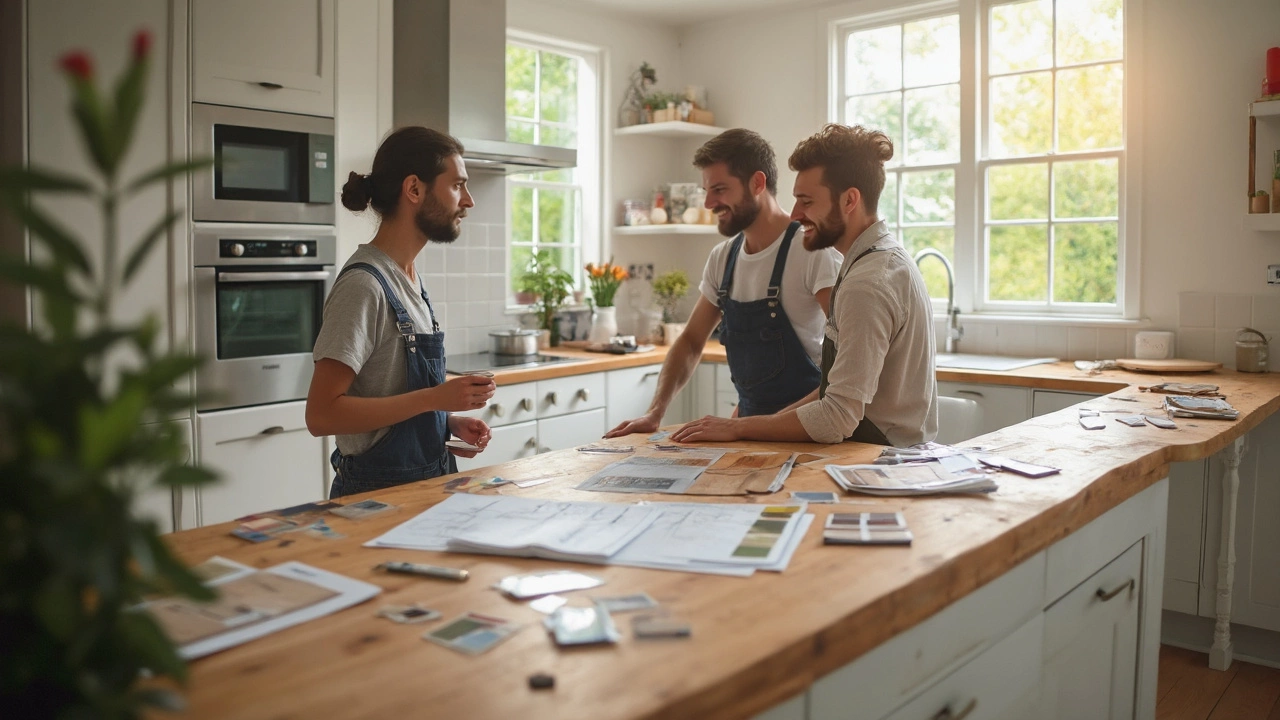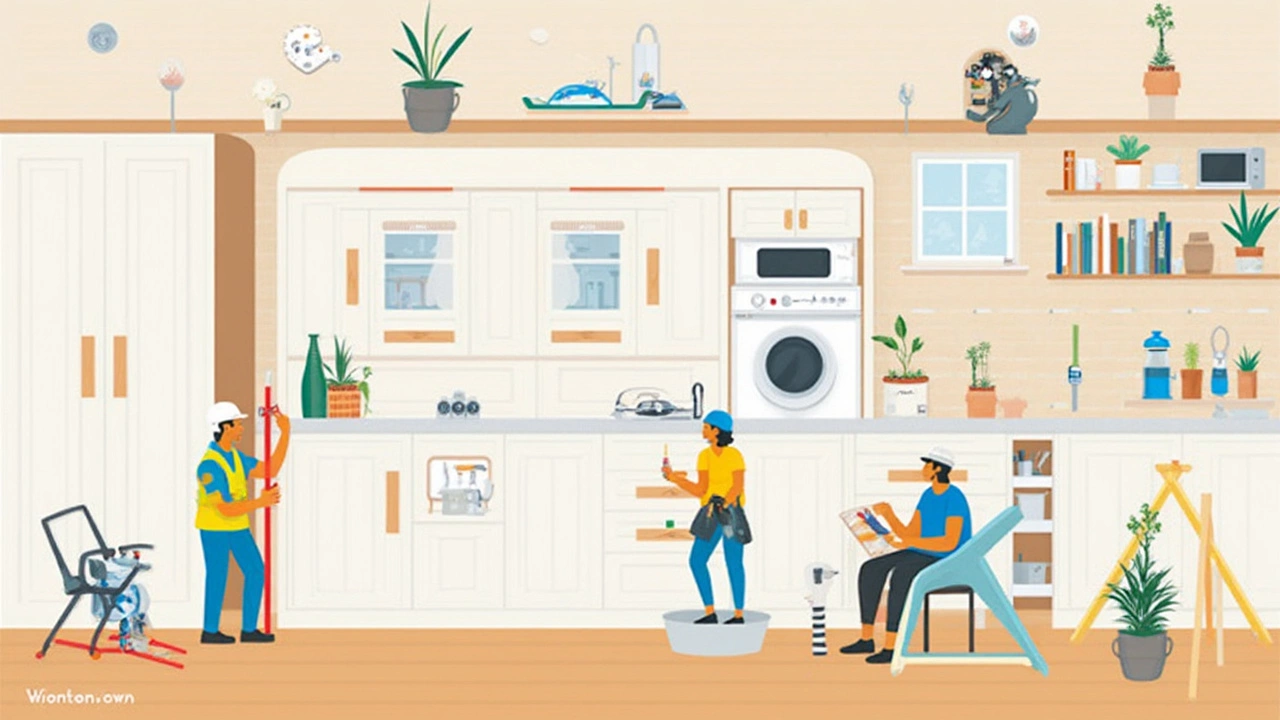Kitchen Fitting Costs in New Zealand: What You Really Pay in 2025

If you’ve ever stared at your old kitchen and imagined it completely gutted and replaced with a modern dream, you probably asked yourself, "How much would it even cost?" Kitchen renovations are notorious for burning holes in wallets, and getting a straight answer is trickier than catching a runaway puppy. There are price tags for every part of this process—from flat-pack basics to bespoke luxury builds, from DIY sweat to full white-glove service. So, what's a reasonable charge to fit a kitchen in New Zealand this year? Let’s pick apart the numbers and see what makes the cost go sky high—or keeps it sensible.
Breaking Down the Kitchen Fitting Bill
Here’s the thing: pricing a kitchen fit isn’t just a matter of phoning up a local tradie and asking for a rate. The final figure depends on a stew of factors, from the type of kitchen you want to the complexity of your space, to the finishing flourishes you ache for. You could pay as little as $3,500 to have a budget flat-pack installed in a tiny rental apartment, or see the final sum balloon north of $30,000 for an architect-designed, high-end kitchen in a sprawling family home. According to a major 2025 local trade report, the median price for a full kitchen fit in Auckland hovers between $8,000 and $15,000. That’s just for the kitchen fitting cost—not including cabinets, appliances, or luxury backsplashes (those are extra!).
Let’s take a look at what makes up a standard fitter’s bill:
- Labour Hours: Experienced installers usually charge $60–$120 per hour. Most standard kitchens take 40–70 hours for a proper fit, depending on complexity. Larger kitchens or tricky layouts rack up more hours.
- Project Management: If your fitter manages other trades (plumbers, electricians, tilers), expect a coordination fee or markup. This ranges from 10–20% of the job cost.
- Materials and Supplies: Fixings, trims, sealants, and waste disposal can add a chunk. Budget $500–$1,500 extra, especially if the kitchen is big or involves demolition.
- Travel and Call-Out: In the city, travel costs might be minimal. Out in rural areas, some fitters add mileage.
- Unexpected Extras: Rotten floorboards, old wiring, or out-of-level walls usually mean more time and money.
Here’s a quick breakdown shown as an average for Auckland as of June 2025:
| Task | Low-end Price | High-end Price |
|---|---|---|
| Standard Labour (40 hrs) | $2,400 | $4,800 |
| Material & Fixings | $500 | $1,500 |
| Project Management Fee | $800 | $1,800 |
| Travel/Call-Out | $100 | $300 |
| Extras/Contingency | $500 | $2,000 |
| TOTAL | $4,300 | $10,400 |
Of course, this doesn’t include new cabinets, appliances, or luxury finishes. Those are often itemized separately.
What Influences the Price of Kitchen Fitting?
Not all kitchens are born equal. Here’s what shoots your price up—or keeps it under control:
- Size and Layout: Installing in a compact apartment is cheaper than a big L-shaped or open-plan space. An average Kiwi kitchen is about 10–14 square meters, but if you’re wrestling with a 20-square-meter chef-style kitchen (think double ovens, butler’s sink, scullery), everything takes longer and costs scale up fast.
- Type of Cabinets: Are you going for entry-level Mitre 10 flat-packs or high-end, made-to-order cabinetry? Some installers charge more for assembling custom cabinetry with integrated appliances or clever storage solutions. Flat-pack kitchens generally install quicker, saving on labour.
- Quality of Fixtures and Fittings: If you pick ultra-heavy benchtops, handleless drawers, or fancy splashbacks, prep and installation get slower and pricier. Stone benchtops, for example, usually need a separate crew to fit, which means more cost.
- Existing Room Condition: Straightforward swaps (pull out, fit new in same place) are a breeze. If there’s water damage, dodgy electrics, or you change the layout and need new plumbing, you’ll pay more—sometimes a lot more.
- Access and Location: Have you got lift access, or does everything have to come up a rickety stairwell? Tight access means longer install times. Auckland city centre installs can sometimes cost more due to parking headaches or building restrictions.
- Choice of Installer: A registered master builder will charge more than a mate, but you get a better finish, insurance, and less stress. NZ’s Certified Builders Association recommends quoting with at least two to three trusted fitters before deciding, as prices can vary widely even for similar work.
- Schedule and Timing: The busiest months are February to May and again October to November (just before Christmas rush). Some fitters offer a discount in slower seasons or for projects booked well ahead.
I once heard about a job where the homeowner saved $2,500 by prepping the site, hauling waste to the skip, and taking care of the painting. Little things like this can tip the scale when you’re on a tight budget.

Is It Worth Paying a Pro or Going DIY?
If DIY’s tempting you, you’re not alone. Plenty of Kiwis back themselves to save by rolling up their sleeves. Mitre 10 and Bunnings run kitchen fitting workshops across Auckland, and you’ll spot video guides everywhere. So how much can you really save going it alone?
The average home DIY-er can chop a few thousand from the bill if they:
- Are handy with tools and have at least basic carpentry skills
- Don’t mind trading weekends and annual leave for time under the bench
- Stick to flat-pack cabinets and straightforward layouts
- Get tradies for electrics and plumbing (NZ law demands it)
But—here’s the kicker—DIY mistakes cost more than hiring a professional in the first place. Insurance claims spike each year from botched plumbing, leaks, or accidental tool-through-the-wall disasters. Most professionals bring years of experience, warranties, and insurance. A 2024 survey by Consumer NZ found that three out of five DIY kitchen renovators faced hidden costs they hadn’t budgeted for—usually repairs after hitting a snag. So, if you crave peace of mind or you want a high-standard, hassle-free job, paying a pro just makes sense.
Still, if you’re keen on shaving down costs, ask your installer which “grunt work” you could take on yourself. Site clearing, skip runs, or even demo’ing the old kitchen under supervision can cut paid labour hours by 10–20%. Don’t be afraid to negotiate—it’s more common than you think in the current market.
Tips for Controlling Your Kitchen Fitting Budget
Now for the brass tacks. You want a great kitchen, but you don’t want to be eating beans on toast for the rest of the year. Here’s how to get a strong finish without draining your savings:
- Get Detailed Quotes: Avoid ‘guestimate’ quotes. Make sure you get a full breakdown. Check exactly what’s included (like waste removal, appliance fitting). Detailed quotes help you compare apples with apples.
- Lock Down Plans: Decide on your layout and appliances before work starts. Mid-job changes slow things and cost extra.
- Shop Around for Cabinets: There are big price swings between flat-pack, bespoke, and semi-custom. End-of-line sales from big chains can save hundreds.
- Do Some Prep: Clearing out, old cabinet removal, prepping wall spaces—many fitters are happy if the site’s ready to go.
- Time Your Project: If you’re not in a rush, book for off-peak times. Late June and July are usually quieter. Some tradies pass on savings.
- Avoid Over-Specifying: It’s tempting to splurge, but imported taps and solid-surface counters cost a bomb. Choose mid-range fittings for price and durability.
- Keep the Same Layout: Moving plumbing or electrics is where costs really stack up. Keeping everything in its place makes fitting simpler.
If you want extra peace of mind, see if the installer is part of a trade association, and always check for references before signing a contract. Most reputable Auckland kitchen fitters quote for free—so don’t be shy about talking to a few before settling.

How to Choose a Kitchen Installer You Can Trust
So you've nailed down your designs, picked your cabinets, and saved a tidy sum to get that perfect kitchen in place. How do you find someone who will do a top job, on time, without blowing your budget?
Start with trusted sources—word of mouth, neighbours, and social media community groups in Auckland are your best bet for honest feedback. Check Google or NoCowboys reviews, but read between the lines for quality, not just star ratings.
Here’s a quick checklist for vetting your kitchen fitter:
- Qualifications: Are they a member of New Zealand Certified Builders or a Registered Master Builder?
- Insurance: Ask for proof of liability insurance for kitchen fitting jobs.
- Portfolio: Check their recent work. Good installers love showing off before-and-afters!
- References: Ask for two recent clients you can chat with—either by phone or in person.
- Written Contract: Even for simple jobs, get everything in writing—scope, price, payment terms, and timeline.
- Communication: Pay attention to how quickly they respond to queries. Good fitters keep you in the loop, not in the dark.
And finally—if a quote seems way lower than everyone else’s, proceed with caution. Sometimes, you get what you pay for, and that bargain job can end up costing you twice if corners get cut.
Nailing the balance between cost and quality is always tricky, but with a bit of research—and a few Kiwi tips up your sleeve—you’ll land a kitchen that does your home proud without draining your rainy-day fund. Enjoy the process… and maybe leave a pizza in the fridge for your hardworking fitters!
